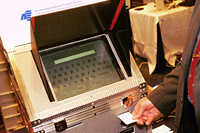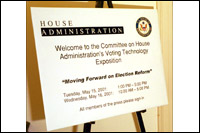
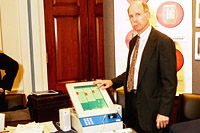
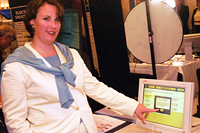
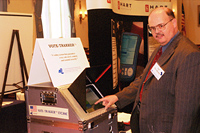
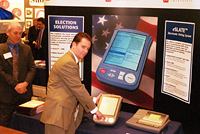
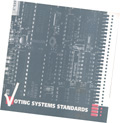
The Federal Election Commission
issued voluntary standards for voting systems in January 1990 ("Performance
and Test Standards for Punchcard, Marksense, and Direct Recording Electronic
Voting Systems"). It began the process of revising these standards
in the late 1990s.
Among the thirteen companies presenting voting systems were some of the biggest names in the field, firms with decades of elections experience. Also represented were several companies prompted to have a shot at building a better voting machine by the historic November 2000 election.
With punch-card systems now in great disfavor, the leading technologies are touch screen and optical scan, which uses a Scantron-like form. Many states require that voting systems be certified by the National Association of State Election Directors. NASED utilizes independent testing authorities to test both software and hardware, based on voluntary standards (history) developed by the Federal Election Commission.
Each of the designs presented at the expo has advantages and disavantages. For example, looking at touch screen systems, there are a range of possibilities. The screen itself can be liquid crystal display or cathode ray monitor; it can be monochrome or color. A small screen uses less energy, but it also requires the voter to scroll through many pages if there is a long ballot. The presentation of the ballot on the screen is also important. Is it intuitive? Are the fonts sizable?
In addition to such essentials as accuracy and security, many other factors enter into the equation. For poll workers, the system should be easy to set up and run. Voting systems should be easy for all voters, including seniors and the disabled, to use. Indeed, the new systems typically allow the blind, listening to an audio ballot through headphones, to vote. Looking at cost, software is a major expense. In terms of hardware, some systems employ off-the-shelf components, meaning that costs for repair can be kept down. A system that does not use paper ballots entails considerable savings, but in the absence of a paper trail, voter trust becomes an issue.
To avoid making potentially costly mistakes, election administrators must consider a host of such factors to determine which of the available systems best suits their particular jurisdiction.
Progress in upgrading outmoded voting systems by the 2002 and 2004 elections depends heavily on funding. Doug Lewis, executive director of the Election Center, puts the cost to replace a voting machine at about $3,500 per unit, although actual costs depend on the specifics of individual contracts. Monies to upgrade voting technology will likely come from a combination of federal, state and local sources.
Leading bills in Congress would create a grant program; for example Rep. Steny Hoyer (D-MD)'s Voting Improvement Act (H.R.775) provides a maximum of $6,000 per precinct. At the state level, the Florida legislation, signed by Gov. Jeb Bush on May 9, 2001, provides $7,500 per precinct in small counties and $3,750 per precinct in large counties. Other states are not moving as quickly, however.
Election Data Services estimates that, as of 1998, punch card systems were used in counties with about 32.4% of the population (more than one-third of precincts), optical scan 27.2%, lever machines 18.2%, electronic 8.9%, Datavote 4.0%, paper ballots 1.4%, and mixed 7.9%. > Given that the Committee on House Administration has set as one of its five principles "elimination of punch-card voting systems," upgrading voting technologies will be an expensive proposition.
